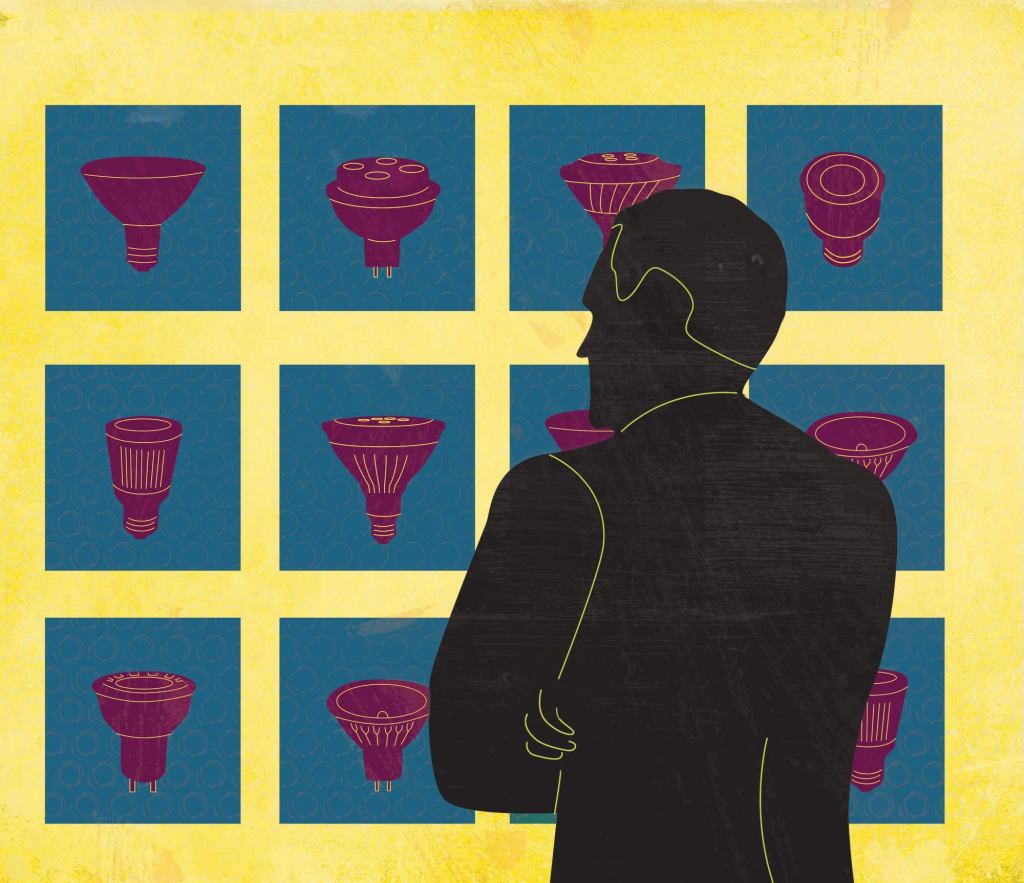Mike Krames, chief technology officer of the startup LED manufacturer Soraa, contends that the CFL era will be historically brief. The CFL sector “blew it,” he says. They didn’t see any other technology coming down the pike [and] ignored LEDs. … Having come from a company [Philips Lumileds] that made both, I can tell you there’s a lot of consternation [about] how to do that transition.” The only metric favoring CFLs, Krames believes, is initial cost, a variable that is skewed by rebates.
“CFLs will remain viable as long as they’re cheaper than LEDs,” Vedder says. GE’s Howley notes that CFLs outperform halogens in longevity, lasting about 8,000 hours rather than 1,000, and that the NEMA Premium standard for ballasts provides a shorthand for reliability. As for progress in color quality, Mary Beth Gotti, director of General Electric’s Lighting Institute in Nela Park, Ohio (just outside Cleveland), has noted that visitors to the institute pick CFLs over filaments approximately half the time in randomized comparisons.
Upgraded linear fluorescents are also alive and well: Ford, of Osram Sylvania, cites her employer’s T8 model, the Octron XPXL (Extended Performance Extended Life), that is estimated to last up to 84,000 hours on programmed start or 75,000 hours on instant start. The economics, she suggests, indicate that the T8 form factor, unlike PAR, is not yet ripe for LED conversion, except in settings that are hard to reach or require shatter resistance. High-performance linear fluorescents can also be combined with the same firm’s Powersense zero-to-10V dimming ballasts and/or a lighting-management system such as Encelium, a flexible nonproprietary protocol. With more established management systems for fluorescents than for LEDs, major migrations to linear LED lamps are unlikely for about five or more years, Ford says.
LEDs: Proceed with Eyes Wide Open
For the foreseeable future, LEDs are the fastest-expanding sector. If the descent of some LED prices to $10 per lamp is any indication, this tendency should accelerate—particularly, Ford notes, when the Zhaga Consortium’s industry-wide voluntary fixture specifications, currently being organized into seven spec books, catalyze widespread interchangeability among LED engines, heat sinks, and drivers (See “Z is for Zhaga”). Another reason for greater LED adoption, she adds, is the increasingly tight wattage-per-square-foot requirements as states review their energy codes; the DOE, she notes, is requiring such reviews by October of this year and the adoption of ASHRAE 90.1/2010 or equivalent.
Rapid technical progress and price reductions make it difficult to find the optimal time to convert to LEDs, though the extended payoffs are usually worth the trouble. Efficiency improvements in the LED realm, Vedder says, don’t quite keep pace with the 18-month power-doubling period that Moore’s Law associates with microchips, but they are still occurring fast enough to create a dilemma between early and later adopters. Gonzalez sees new breakthroughs in LEDs appearing every few months, in some cases, every 90 days.
Replacing other lamps with LEDs requires attention to fixtures and often a conversation with a lighting manufacturer or consultant. “Any time that you have an electronic circuit and not just a resistor, you have to translate the input to [the] dimming function through the electronics,” Vedder says. “And any time you do that, you can have some compatibility issues.”
Mixing older and newer LEDs on the same dimmer circuit is a common source of uneven performance or shortened lamp life. These problems can occur whether lamps are labeled as dimmable or nondimmable, Howley says. Industry standards for dimming control are in an early evolutionary stage; some dimmers take lamps down to 20 percent of their maximum output and some down to 1–2 percent, while others involve awkward step-down functions. Though manufacturers provide dimming curves and compatibility information online, all the sources for this article suggest that direct testing of sample lamps gives better results than choices based on spec sheets. Ford recommends equipment with trailing-edge dimming curves rather than a four-phase cut. Inrush current can limit the number of lamps that can go on a single circuit, and when low-wattage LEDs replace incandescents, the relation is not always linear. (One-sixth the wattage per lamp does not mean it’s OK to use six times as many lamps on a circuit.) “With LEDs,” Ford says, “it’s always good to install a few before you make any decision.”
The only predictable thing about the LED field appears to be its unpredictability. Gonzalez contrasts it to an earlier technology, still valued for applications where slow warmup times aren’t a problem: “For many years, we thought we’d hit the wall in metal halide performance, and then we had a breakthrough called ceramic metal halide technology, which took it a little bit further. But we were measuring those breakthroughs every five to seven years, or every 10. … With LED technology, we’re making a breakthrough every seven months. So you ask the question: ‘What is the finite limit of LED performance?’ They’re still plumbing it. They haven’t found the wall yet.”
